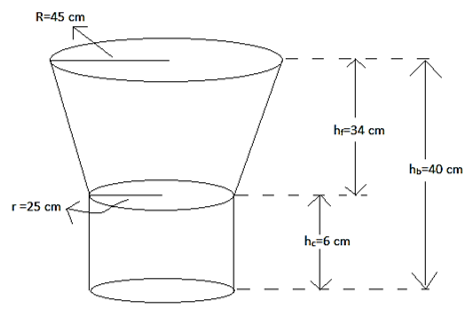An open metal bucket is in the shape of a frustum of a cone, mounted on a hollow cylindrical base made of the same metallic sheet. The diameter of the two circular ends of the bucket are 45 cm and 25 cm, the total vertical height of the bucket is 40 cm and that of the cylindrical base is 6 cm. Find the area of the metallic sheet used to make the bucket. Also, find the volume of water the bucket can hold, in litres.

Given: radius of upper circular end of frustum = R = 45 cm
Radius of lower circular end of frustum = radius of cylindrical base = r = 25 cm
Height of bucket = hb = 40 cm
Height of cylindrical base = hc = 6 cm
From the figure height of frustum = hf = hb - hc
= 40 - 6
∴ hf = 34 cm
![]()
Volume of cylinder = πr2hc
Curved surface area of cylinder = 2πrhc
curved surface area of frustum = π(R + r)l cm2
Where l = slant height
![]()
![]()
= √(400 + 1156)
= 39.44 cm
Area of metallic sheet used = curved surface area of frustum + curved surface area of base
cylinder + area of base circle of cylinder
now, curved surface area of frustum = π × (R + r) × l cm2
= (22/7) × (45 + 25) × 39.44 cm2
= 22 × 10 × 39.44 cm2
= 8676.8 cm2
Curved surface area of base cylinder = 2πrhc
= 2 × (22/7) × 25 × 6
= 942.85 cm2
Surface area of base circle of cylinder = πr2
= (22/7) × 252
= 1964.28 cm2
∴ Area of metallic sheet used = 8676.8 + 942.85 + 1964.28
= 11583.93 cm2
Therefore, area of metallic sheet used to make the bucket is 11583.93 cm2 i.e. 1.158393 m2
Volume of water bucket can hold = volume of bas cylinder + volume of frustum
Volume of base cylinder = πr2hc
= (22/7) × 252 × 6
= 11785.71 cm3
![]()
![]()
= 35.62 × 3775
= 134465.5 cm3
∴ volume of water bucket can hold = 11785.71 + 134465.5
= 146251.21 cm3
Now 1 litre is 1000 cm3
∴ 146251.21 cm3 = 146251.21/1000 = 146.25121 litres
Volume of water bucket can hold = 146.25121 litres